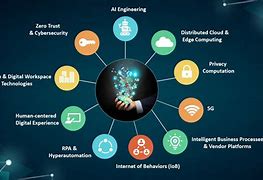
The tech landscape is a wild and exciting place, changing faster than you can say “quantum computing”. But with all these cutting-edge advancements, it’s easy to feel overwhelmed, unsure where to even start! Don’t worry, though. This step-by-step guide will equip you with the knowledge and skills to master the latest tech trends, whether you’re a curious newbie or a seasoned pro looking to level up. We’ll dive deep into everything from artificial intelligence (AI) & machine learning to the metaverse and blockchain, breaking down the basics and showing you how to apply these powerful technologies in your life & work. So, buckle up, let’s embark on this exhilarating journey together. Get ready to explore the future of tech – and learn how you can shape it.
Mastering the Latest Tech Trends: A Step-by-Step Guide
The world of technology is constantly evolving, with new trends emerging at a breakneck pace. Staying ahead of the curve is crucial for individuals and businesses alike, as tech trends have a profound impact on industries, careers, and our daily lives. This thorough guide will offer a step-by-step approach to understanding and mastering the latest tech trends, empowering you to navigate the future of technology.
Related Post : Telegram gives explanation after their boss was arrested in France
Why Understanding Tech Trends is Crucial
In today’s rapidly changing world, understanding tech trends is no longer optional, it’s essential. Whether you’re a student, a professional, or simply someone interested in the future, embracing the latest advancements in technology can unlock new opportunities, enhance your skillset, and give you a rival edge.
What are Tech Trends and Why Should You Care?
Tech trends are innovative ideas, technologies, and developments that are gaining significant traction and influence in the tech landscape. They shape how we live, work, and interact with the world around us. Understanding tech trends allows you to:
- Stay informed about the future: Anticipate changes in industries, businesses, and society.
- Enhance your career: Develop skills in demand and explore exciting new job opportunities.
- Gain a rival benefit: Leverage emerging technologies to innovate and solve problems.
- Make informed decisions: Understand the potential impact of tech trends on your personal and professional life.
The Impact of Tech Trends on Industries and Careers
Tech trends are transforming industries across the board, from healthcare and finance to education and manufacturing. They are driving automation, improving efficiency, creating new products and services, and changing the way we work. As a outcome, they are also reshaping the job industry, creating a demand for professionals with specialized tech skills.
Examples of Recent Tech Trends Shaping the World
The world is witnessing a rapid evolution of technology, with numerous trends emerging and shaping our lives. Here are some prominent examples:
- Artificial Intelligence (AI): AI-powered systems are revolutionizing industries by automating tasks, providing insights, and personalizing experiences.
- Machine Learning (ML): A subset of AI, ML enables computers to learn from data and make predictions without explicit programming.
- Big Data and Analytics: The ability to collect, analyze, and interpret massive datasets is transforming businesses and helping them make data-driven decisions.
- Cloud Computing: Cloud services are enabling businesses and individuals to access computing resources on demand, enhancing flexibility and scalability.
- Internet of Things (IoT): The interconnected network of devices is creating a world where physical objects communicate and share data.
- Cybersecurity: As technology becomes more interconnected, cybersecurity is becoming increasingly critical to protect data and systems from threats.
Step 1: determineing Emerging Tech Trends
Staying ahead of the curve requires constant vigilance and a commitment to staying informed about the latest developments. Here’s how to stay on top of emerging tech trends:
Staying Informed: How to Find and Follow the Latest Tech News
- Subscribe to tech news websites and blogs: TechCrunch, Wired, The Verge, and MIT Technology Review offer insightful articles and examination.
- Follow influential tech personalities on social media: Engage with thought leaders and industry experts on Twitter, LinkedIn, and Facebook.
- Listen to tech podcasts: Explore podcasts like “TechStuff,” “Recode Decode,” and “The Daily.”
studying Industry Reports: Leveraging Reports from Gartner, Forrester, and Others
- Gartner: Gartner’s “Hype Cycle” is a widely respected examination of emerging technologies, their maturity, and their potential impact.
- Forrester: Forrester’s study focuses on the impact of technology on businesses and consumers, providing actionable insights.
- IDC: The International Data Corporation (IDC) offers thorough industry study on various tech sectors.
Attending Industry Events: Conferences, Webinars, and Workshops
- Conferences: Major tech conferences like CES, SXSW, and Web Summit offer opportunities to network and learn about the latest innovations.
- Webinars: Online webinars hosted by tech companies and industry experts offer insights on specific tech trends.
- Workshops: Hands-on workshops allow you to gain practical experience with emerging technologies.
Step 2: Exploring Key Tech Trends
Once you have a grasp of the emerging tech trends, it’s time to delve deeper into the most impactful ones. Understanding their applications, benefits, and challenges will help you make informed decisions and leverage them effectively.
Artificial Intelligence (AI)
What is AI and How is it Evolving?
AI refers to the ability of computer systems to perform tasks that typically require human intelligence, such as learning, problem-solving, and decision-making. Advancements in machine learning, deep learning, and natural language processing are driving rapid progress in AI development.
Applications of AI in varied Industries
- Healthcare: AI is used for disease diagnosis, drug discovery, and personalized medicine.
- Finance: AI powers fraud detection, risk assessment, and automated trading.
- industrying: AI is used for personalized recommendations, targeted advertising, and sentiment examination.
- Manufacturing: AI-powered robots are automating tasks, improving efficiency, and enhancing safety.
Ethical Considerations and the Future of AI
As AI becomes more sophisticated, ethical considerations become increasingly crucial. Issues such as bias, privacy, and job displacement need to be addressed to ensure the responsible development and deployment of AI. The future of AI holds immense potential for good, but it also requires careful consideration and responsible stewardship.
Machine Learning (ML)
Understanding the Basics of Machine Learning
Machine learning is a subset of AI that allows computers to learn from data without explicit programming. Algorithms are trained on datasets, enabling them to determine patterns, make predictions, and improve their performance over time.
The Relationship Between AI and ML
Machine learning is a key component of AI, providing the algorithms and techniques that power many AI systems. However, AI encompasses a broader scope of technologies, including natural language processing, computer vision, and robotics.
Real-World Examples of Machine Learning Applications
- Image recognition: ML algorithms are used to determine objects in images, such as facial recognition and medical imaging examination.
- Spam filtering: ML models analyze emails and determine spam messages.
- Personalized recommendations: ML algorithms analyze user behavior and preferences to suggest products, movies, or music.
Big Data and Analytics
The Importance of Data in Today’s World
Data is the fuel that powers innovation and decision-making in the digital age. Businesses are collecting massive amounts of data, and the ability to analyze this data effectively is crucial for achievement.
Tools and Technologies for Big Data examination
- Hadoop: A framework for processing large datasets distributed across multiple servers.
- Spark: A fast and general-purpose cluster computing platform for big data processing.
- NoSQL databases: Databases designed to handle large volumes of unstructured data.
Data Privacy and Security Concerns
The collection and examination of big data raise concerns about privacy and security. It is crucial to implement strong measures to protect sensitive data and ensure responsible use of data.
Cloud Computing
The benefits of Cloud Computing for Businesses and Individuals
- Cost savings: Cloud computing eliminates the need for expensive hardware investments and reduces maintenance costs.
- Scalability: Cloud services allow businesses to scale their computing resources up or down as needed.
- Flexibility: Cloud computing offers access to a wide scope of services, including storage, databases, and analytics.
varied Cloud Computing Models (IaaS, PaaS, SaaS)
- Infrastructure as a Service (IaaS): offers access to computing resources like servers, storage, and networking.
- Platform as a Service (PaaS): Offers a platform for developing and deploying applications.
- Software as a Service (SaaS): offers access to software applications over the internet.
Choosing the Right Cloud offerr for Your Needs
There are numerous cloud offerrs, each with its own strengths and weaknesses. Choosing the right offerr depends on your specific requirements, budget, and technical expertise.
Internet of Things (IoT)
Connecting the Physical and Digital Worlds
The Internet of Things refers to the network of physical devices, vehicles, buildings, and other objects embedded with sensors, software, and connectivity that enable them to collect and exchange data.
Applications of IoT in Smart Homes, Cities, and Industries
- Smart homes: IoT devices automate tasks like lighting, temperature control, and security.
- Smart cities: IoT sensors collect data to improve traffic flow, manage energy consumption, and maximize public services.
- Industry 4.0: IoT technologies are transforming manufacturing processes, improving efficiency, and enhancing productivity.
The Future of IoT and its Potential Impact
The IoT is expected to continue expanding, connecting billions of devices and transforming industries and our daily lives. This interconnected network holds immense potential for innovation and progress, but it also raises concerns about privacy, security, and ethical implications.
Cybersecurity
The Growing Importance of Cybersecurity
As technology becomes more interconnected, cybersecurity is becoming increasingly critical to protect individuals, businesses, and governments from cyber threats.
Common Cybersecurity Threats and How to Protect Yourself
- Malware: Malicious software designed to harm computers or steal data.
- Phishing: Tricking users into revealing sensitive information.
- Ransomware: Software that encrypts data and demands a ransom for its release.
optimal Practices for Strong Cybersecurity
- Use strong passwords and multi-factor authentication.
- Keep software updated with the latest security patches.
- Be cautious of suspicious emails and links.
- Back up your data regularly.
Step 3: Developing Skills and Knowledge
To fully leverage the power of tech trends, it’s essential to develop the necessary skills and knowledge. This involves upskilling, reskilling, and continuous learning.
Upskilling and Reskilling for Tech Careers
- determine in-demand skills: study job postings and industry trends to determine the skills most sought after in tech fields.
- Develop technical skills: Acquire programming languages, data examination techniques, and cloud computing skills.
- Enhance soft skills: Develop communication, problem-solving, and teamwork skills.
Online Learning Platforms and Resources
- Coursera: Offers online courses from top universities and companies.
- Udemy: offers a wide scope of courses on various tech topics.
- Codecademy: Offers interactive coding tutorials for beginners.
- Khan Academy: offers complimentary educational resources in various subjects, including computer science.
Networking with Industry Professionals
- Attend industry events: Connect with professionals in your field and learn from their experience.
- Join online communities: Engage in online forums and groups dedicated to tech trends and career development.
- Reach out to mentors: Seek guidance and advice from experienced professionals in your chosen field.
Step 4: Applying Tech Trends in Your Work and Life
The final step in mastering tech trends is applying them in your work and daily life. This involves determineing opportunities to leverage emerging technologies to enhance productivity, create new solutions, and navigate a changing world.
Utilizing Tech Trends for Personal Productivity
- Use AI-powered productivity tools: Tools like Grammarly, Asana, and Google Calendar can enhance productivity and efficiency.
- Automate tasks: Leverage automation tools to streamline repetitive tasks and complimentary up time for more strategic work.
- Embrace cloud storage and collaboration tools: Utilize cloud services like Google Drive, Dropbox, and Slack to access files and collaborate remotely.
Finding Tech-Related Job Opportunities
- Network with industry professionals: Build relationships with people in your field to learn about open positions.
- Use online job boards: Websites like LinkedIn, Indeed, and Glassdoor list tech-related job openings.
- Consider complimentarylancing platforms: Platforms like Upwork and Fiverr offer opportunities to work on tech projects.
Starting a Tech-Based Business
- determine a problem to solve: Look for opportunities to leverage tech trends to address unmet needs.
- Develop a business plan: Outline your business model, target industry, and financial projections.
- Build a strong team: Assemble a team with the skills and expertise necessary to execute your vision.
Conclusion: Embracing the Future of Technology
Mastering the latest tech trends is an ongoing journey that requires continuous learning, adaptation, and a willingness to embrace the future of technology. By staying informed, developing essential skills, and applying your knowledge, you can unlock new opportunities, enhance your career, and contribute to the innovative world of tomorrow.
The Importance of Continuous Learning
Technology is evolving at an unprecedented pace, so it’s crucial to stay updated with the latest developments. Make continuous learning a habit by subscribing to tech news, attending industry events, and exploring new technologies.
Staying Ahead of the Curve in a Rapidly Evolving Tech Landscape
The tech landscape is constantly changing, so it’s crucial to be agile and adapt to new trends as they emerge. Embrace a growth mindset and be willing to learn new skills and technologies.
The Potential of Tech to Drive Innovation and Change the World
Technology has the power to drive innovation, solve global challenges, and improve lives. By embracing the latest tech trends, we can contribute to a brighter future and harness the potential of technology to make a positive impact on the world.



